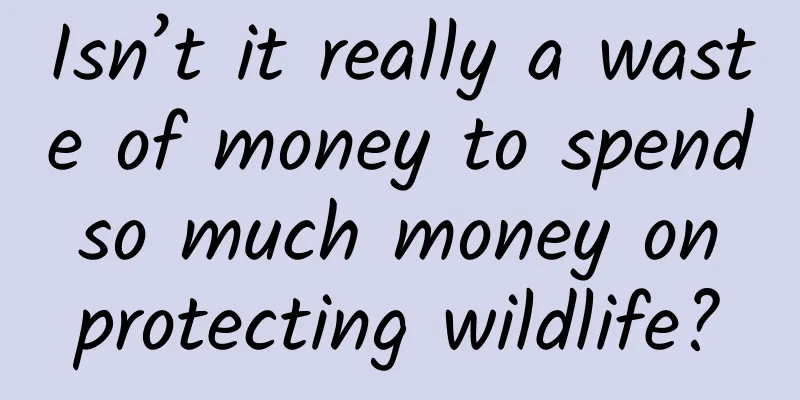Isn’t it really a waste of money to spend so much money on protecting wildlife?

|
Protecting wildlife can help the Earth have a higher diversity of species and maintain a more stable ecological environment. However, many people believe that instead of spending a lot of money to save distant wildlife, it is better to use the money elsewhere - isn't protecting animals a waste of money? Protecting wildlife seems to be something that requires money and effort but the results are not obvious | Zhihu question A recent paper published in Nature Ecology & Evolution made an economic calculation from the perspective of climate change - India's economic benefits from protecting endangered wild tigers not only fully covered its expenses, but also brought in tens of millions of dollars in additional economic benefits . India has established a large number of protected areas to protect wild tigers | Ashish Kale How is protecting endangered wildlife related to climate change? And how can such huge economic benefits be calculated? After the Tigers Return Three-quarters of the world's wild tigers live in India, where their numbers have plummeted due to habitat destruction - from 40,000 in 1947 to just 1,500 in 2006. To protect this endangered species, India has established 53 nature reserves , strictly restricting deforestation and protecting their habitats from destruction. Tigers have become India's " umbrella species ," just like China's giant pandas. Umbrella species is a concept in the field of biological conservation, meaning that the living environment of this species covers the living environment of a large number of other species. So while protecting wild tigers, it also provides an umbrella for other species in the forest, benefiting the entire ecosystem . In addition to "umbrella species", there are also "flagship species", which are species that can attract public attention, be loved, attract attention, and attract donations. |Manpreet Romana If tigers are well protected, they can also make money , but not from tourists, but from forests . Carbon sink function of forests In recent years, people have increasingly felt the imminent problem of global warming - summers are getting hotter and hotter, and various climate disasters are happening more frequently. Humans have emitted a large amount of greenhouse gases, including carbon dioxide , which is one of the main causes of global warming. To control greenhouse gases, in addition to reducing emissions, we can also absorb more carbon dioxide, the most common way being to plant more trees. Forests are natural warehouses that absorb and store carbon compounds, also known as "carbon sinks." A single tree can absorb about 21 kilograms of carbon dioxide a year. A rainforest as large as the Amazon can normally absorb 2.2 billion tons of carbon dioxide a year, accounting for 5% of the world's annual emissions. In addition to trees, wetlands, grasslands and oceans are also important carbon sinks. These ecosystems play an irreplaceable role in reducing the concentration of carbon dioxide in the atmosphere and alleviating global warming. | WWF To reduce emissions, human activities must be restricted, which is mutually exclusive with economic development to some extent. Since forests, as "carbon sinks", help reduce carbon emissions, they can offset some of the economic losses caused by carbon emissions reduction. This is particularly important for India, the world's third largest greenhouse gas emitter. The study found that the tiger reserves established in India over the past 20 years have protected at least 6,000 hectares of forest from being cut down, equivalent to more than 1 million tons of carbon emissions. After conversion, this saved India more than $93 million in carbon reduction costs, more than a quarter of the annual budget invested in tiger reserves . Although only a small part, it is enough to prove that investment in wildlife protection can be repaid in other forms. There are currently 53 tiger reserves in India, covering a total area of 75,796 square kilometers, which is about 2% of India's land area. | Aakash Lamba Wildlife is also a carbon sequestering powerhouse Because trees absorb carbon dioxide directly from the air, planting more trees is the most straightforward way to increase carbon sinks. However, wildlife is also an important part of carbon sequestration . Wildebeest The wildebeests that live on the African savannah are a good example. They are known for their annual "Great Migration". Every year, more than one million wildebeests move northward from the southern Serengeti savannah in search of abundant pastures. The great migration of wildebeests|www.serengeti.com However, in the early 20th century, the wildebeest population plummeted to 300,000 due to a disease spread by domestic animals. As the migratory animals declined, the grass became difficult to control, eventually fueling wildfires and releasing large amounts of carbon dioxide, turning the grasslands from a "carbon sink" into a "carbon source." As the wildebeest population recovered, grassland fires decreased accordingly, and the grassland gradually turned back into a "carbon sink", storing 4.4 million tons of carbon dioxide more than when the wildebeest population was the lowest . African forest elephant African forest elephants are called "gardeners of the forest", but they do not prune trees. Instead, they influence the tree species composition of the forest by "eating" . African forest elephants, known as forest gardeners | Wikipedia African forest elephants can eat 200 kilograms of plants every day. After investigation, people found that they would give priority to leaves that are easy to digest . These tree species tend to grow fast, but the carbon density they contain is lower, which is not conducive to the forest's carbon sequestration capacity. Slow-growing trees usually have a high carbon density, and their leaves generally have defense mechanisms, which are difficult for elephants to eat. Therefore, after being gnawed by the elephants, trees with better carbon sequestration effects are more likely to grow . In addition, trees with high carbon density have more attractive fruits . After the elephants eat the fruits, they can carry the seeds to all parts of the forest. Therefore, the elephants' dietary preferences promote the growth and spread of trees with high carbon density , changing the structure of the forest, allowing it to store more carbon. Baleen whale The role of whales in the ocean in reducing carbon emissions cannot be underestimated, especially baleen whales. The species we are familiar with include right whales, blue whales, fin whales, etc. Baleen whales cannot chew, but instead filter their food - opening their huge mouths to swallow dozens of tons of seawater, including small fish and shrimp. As the world's largest mammal, their appetite is astonishing. A decade-long study found that baleen whales eat about 16 tons of krill every day, equivalent to three adult African elephants. Baleen whales eat small krill, and their excrement feeds countless diatoms and other phytoplankton. |Victor Smetacek After the feast, the baleen whales' poop feeds some phytoplankton, causing it to multiply in large numbers . The huge number of phytoplankton absorbs carbon dioxide for photosynthesis, which in turn feeds the vast marine ecosystem. But today, as whale populations decline, phytoplankton is less abundant than it once was, and the ocean’s ability to sequester carbon has been reduced . If whale populations in the Southern Ocean were to recover, the ocean would absorb as much carbon as an entire continent-covering forest ecosystem. More and more studies have proven that protecting wildlife is not a “losing business.” We can understand how much economic benefit protecting wildlife brings us by evaluating the service value of ecosystems . The service value of this ecosystem includes not only the tourism income it brings to the local area, but also the cost of reducing carbon emissions and the value of mitigating climate warming. In the face of the contradiction between "protection and development", by converting the value of ecosystem services, we can more clearly see how much wildlife protection is worth . By evaluating the value of ecosystem services, how much is wildlife protection worth?|nathab.com But in fact, protecting wildlife is not just an economic calculation. We are not only protecting wildlife, but also protecting humans ourselves , protecting our survival on this increasingly hot planet, and protecting us from the impact of climate change. The earth may not care what we do to it. Even if everything is destroyed, it has plenty of time to recover. But can humans wait for that day? References [1]Savoca, MS, Czapanskiy, MF, Kahane-Rapport, SR et al. Baleen whale prey consumption based on high-resolution foraging measurements. Nature 599, 85–90 (2021). [2] Deli Saavedra, Néstor Fernández, Jens-Christian Svenning, Addressing challenges for large-scale trophic rewilding, Journal for Nature Conservation, 73, (126382), (2023). [3] Holdo RM, Sinclair AR, Dobson AP, Metzger KL, Bolker BM, Ritchie ME, Holt RD. A disease-mediated trophic cascade in the Serengeti and its implications for ecosystem C. PLoS biology. 2009 Sep 29;7(9):e1000210. [4]http://www.magicalkenya.net.cn/index.php?optionid=975 [5]Lamba, Aakash, et al. "Climate co-benefits of tiger conservation." Nature Ecology & Evolution (2023). [6]https://journals.plos.org/plosbiology/article?id=10.1371/journal.pbio.1000210 [7]https://www.anthropocenemagazine.org/2021/11/poo-from-the-worlds-largest-animals-have-a-stunning-effect-on-ocean-ecosystems-and-even-carbon-capture/ Author: Jian Er Editor: Little Towel, Mai Mai Image credit: Ashish Kale This article comes from GuokrNature (ID: GuokrNature) If you need to reprint, please contact [email protected] Welcome to forward to your circle of friends |
>>: Exploring the "Euclid" of the Dark Universe
Recommend
It only takes 3 steps to reduce the cost of information flow advertising. Which step have you taken?
Dear optimizer friends, have you ever encountered...
WeChat's ringtone-changing function has been criticized: it only works within the app
WeChat officially released the iOS 8.0.8 version ...
Performance is seriously "biased" and the market outlook is under pressure. BAIC New Energy plans to acquire a backdoor listing to become the "first stock of new energy vehicles" in the A-share market.
Recently, Chengdu Qianfeng Electronics Co., Ltd. ...
Why do fingers wrinkle after soaking in water? Scientists finally have the answer!
After soaking your hands in water for a long time...
BYD: BYD passenger car sales in May 2024 reached 330,488 units, a year-on-year increase of 38.2%
BYD released its sales report for May. It is repo...
Manufacturers face difficulties, but the domestic smartphone market is far from saturated
It is obvious that domestic smartphone manufactur...
Which Shanghai mini program development company is the best? Shanghai mini program development and production company
In 2017, WeChat launched a new product, mini-prog...
Where will WeChat go in the second half?
[[243547]] Image source: Visual China In the firs...
Baidu Netdisk Super 0 Tutorial Course Materials
Baidu Netdisk Super 0 Tutorial Course Materials 1...
Why are dolphins the nemesis of sharks?
You may have heard that dolphins are sharks' ...
iOS grabs HTML, CSS XPath parses data
In the past, we used AFN to get JSON data. For ex...
6 design highlights to make fission activities successful!
Recently, a friend who works in operations compla...
The giant panda got stuck in the throat, and the keeper Heimlich successfully rescued it! How to save yourself when you are choking on food?
On April 14, in Chengdu, Sichuan, the giant panda...
Tik Tok promotion and monetization operation tutorial!
This video software, which has become extremely p...
How to increase brand marketing exposure for free?
Everyone has put most of their time and energy in...









